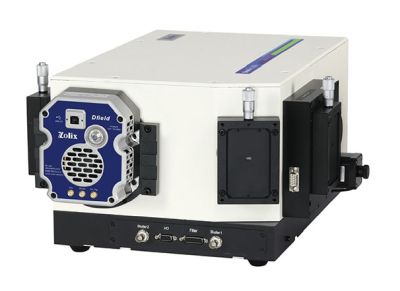spectrographs (original) (raw)
Definition: instruments for spectrally analyzing light, based on a polychromator and a multi-channel photodetector
Alternative term: spectroradiometers
Categories:  general optics,
general optics,  light detection and characterization,
light detection and characterization,  optical metrology
optical metrology
optical metrology instruments
- spectrometers
* spectrographs
* spectrophotometers
* mid-infrared spectrometers
* UV spectrometers
* X-ray spectrometers
- spectrometers
optical metrology instruments
- autocollimators
- beam profilers
- colorimeters
- colorimetry
- frequency metrology
- laser beam characterization
- optical energy meters
- optical frequency standards
- optical power meters
- optical power monitors
- optical profilometers
- optical spectrum analyzers
- optical time-domain reflectometers
- powermeters
- photometry
- polarimeters
- refractometers
- spectrographs
- spectrometers
- spectrophotometers
- wavemeters
- (more topics)
Related: spectrometerspolychromatorsoptical spectrumlaser beam characterization
Page views in 12 months: 388
DOI: 10.61835/tim Cite the article: BibTex BibLaTex plain textHTML Link to this page! LinkedIn
Content quality and neutrality are maintained according to our editorial policy.
📦 For purchasing spectrographs, use the RP Photonics Buyer's Guide — an expert-curated directory for finding all relevant suppliers, which also offers advanced purchasing assistance.
Contents
What are Spectrographs?
Spectrographs are optical instruments which belong to the class of spectrometers. A spectrograph contains a fixed diffraction grating or some other kind of polychromator (a device which can spatially separate different wavelength components of light) and some kind of multi-channel photodetector (e.g. a photodiode array) for measuring the spectral light intensities. (Early versions of spectrographs used photographic plates for recording spectra.) That way one can measure the optical spectrum of a light source. In contrast, some other kinds of spectrometers use a rotating grating and/or a moving detector. Compared with those, a spectrograph often has a simpler setup and can acquire spectra faster, but may not reach the same performance e.g. in terms of spectral resolution or width of the covered spectral region.
A spectroradiometer is a special type of spectrograph, an instrument that has been calibrated to measure absolute radiometric quantities like spectral radiance or irradiance, which is not true for all spectrographs.
The operation principles of spectrographs are explained in the article on spectrometers.
Applications of Spectrographs
Some typical applications of spectrographs are:
- Stellar and solar spectrographs are used for analyzing in detail the radiation from stars. For example, one can measure the locations and strengths of certain absorption lines (Fraunhofer lines) for measuring chemical compositions and relative velocities.
- With a laboratory spectrograph, one may spectrally analyze fluorescence light e.g. from gas discharges or from active optical fibers.
- In spectral phase interferometry, one often requires a spectrograph for measuring the positions of minima and maxima in optical spectra. An intensity calibration is often not required.
- Spectrographs are also used for other methods of pulse characterization, for example for frequency-resolved optical gating.
Frequently Asked Questions
This FAQ section was generated with AI based on the article content and has been reviewed by the article’s author (RP).
What is a spectrograph?
A spectrograph is an optical instrument used to measure the optical spectrum of a light source. It uses a dispersive element, like a fixed diffraction grating, to spatially separate different wavelength components of light and a multi-channel detector to simultaneously record their intensities.
How is a spectrograph different from other types of spectrometers?
Unlike some spectrometers that scan through wavelengths using a moving grating or detector, a spectrograph uses a fixed grating and a detector array to capture a whole range of wavelengths at once. This generally allows for a simpler setup and faster data acquisition.
What are some typical applications of spectrographs?
Suppliers
Sponsored content: The RP Photonics Buyer's Guide contains 23 suppliers for spectrographs. Among them:
⚙ hardware
We can design and manufacture in volume custom spectrographs incorporating original or replicated gratings. Let us precisely assemble easy-to-integrate modules for your instruments.
⚙ hardware
EVEREST, by UltraFast Innovations (UFI®), is a soft X-ray/XUV/VUV spectrograph that features aberration-corrected flat-field imaging and is available with three gratings covering the spectral ranges 1–17 nm (1240–73 eV), 5–80 nm (248–15.5 eV) and 24–200 nm (51.7–6.2 eV). To maximize light collection, the spectrometer can be used without an entrance slit over a variety of source distances, with 3–17 nm, 10–80 nm and 24–200 nm spectral coverage. Its modular design is able to match different experimental geometries and configurations. It features an integrated slit holder, gate valve, and filter insertion unit, as well as a 3-axis motorized grating positioning.
⚙ hardware
Zolix offers various kinds of spectrographs. For example, our ultra-high-performance scientific research CCD spectrograph features outstanding spectral image calibration, high wavelength accuracy, and excellent stray light suppression. It consists of a high-resolution spectrometer and TE-cooled CCD. With its research-grade performance, it is an ideal choice for measuring emission spectrum, fluorescence spectrum and Raman spectrum.
Questions and Comments from Users
Here you can submit questions and comments. As far as they get accepted by the author, they will appear above this paragraph together with the author’s answer. The author will decide on acceptance based on certain criteria. Essentially, the issue must be of sufficiently broad interest.
Please do not enter personal data here. (See also our privacy declaration.) If you wish to receive personal feedback or consultancy from the author, please contact him, e.g. via e-mail.
By submitting the information, you give your consent to the potential publication of your inputs on our website according to our rules. (If you later retract your consent, we will delete those inputs.) As your inputs are first reviewed by the author, they may be published with some delay.





